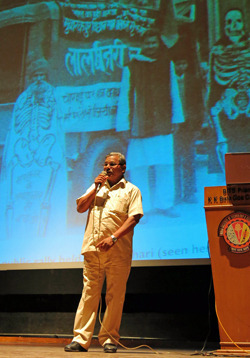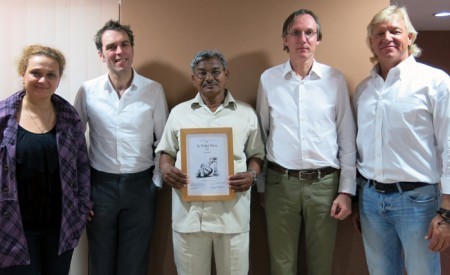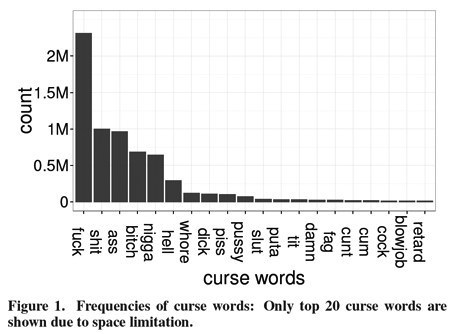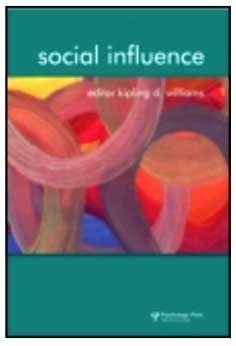Marc Abrahams's Blog, page 424
February 21, 2014
A Gentleman’s Posterior — fashion considerations
This advertisement, showing a gentleman playing billiards in his underwear, promoted the Imperial Underwear Company’s ‘DROP SEAT’ Union Suit, and appeared on page 66 of the Literary Digest, Oct 27, 1917. Approaching one hundred years later the ad. also featured in the paper ‘Considerations on a Gentleman’s Posterior’ (in : Fashion Theory: The Journal of Dress, Body & Culture, Volume 16, Number 2) authored by Shaun Cole who is the Programme Director for the Graduate School Culture and Curation Cluster at University of the Arts, London.
“A series of stylistic and practical developments in the rear openings of men’s underpants in the first quarter of the twentieth century, led to a series of advertisements that depicted men’s rear ends. It is worth noting that representing men in their underwear fell into the interstice between the fully clothed man and the male nude, raising problems around ‘masculine cultural identity, definitions of male discretion, and the engineering principles of the underwear garments vis-à-vis the human body’ (Martin 1992: 19).”
Note: Shaun Cole should not be confused with Shaun Cole, who is a professor at the Institute for Computational Cosmology, Department of Physics, Durham University, UK, and who studies (amongst other things) extragalactic astronomy.
BONUS (Unrelated) “Cosmological considerations regarding Uranus“

February 20, 2014
Lal Bihari ‘Mritak’ meets fellow Ig-winners
 February 9th 2014 was a memorable day in Ig Nobel history. During the Ig Nobel Conclave at the Quark 2014 Techo Management Fest at the BITS Pilani Goa Campus (Goa, India), Lal Bihari, winner of the 2003 Ig Nobel Peace Prize met four fellow Ig Nobel Prize winners.
February 9th 2014 was a memorable day in Ig Nobel history. During the Ig Nobel Conclave at the Quark 2014 Techo Management Fest at the BITS Pilani Goa Campus (Goa, India), Lal Bihari, winner of the 2003 Ig Nobel Peace Prize met four fellow Ig Nobel Prize winners.
Lal Bihari ‘Mritak’ won his prize for (1) leading an active life even though he has been declared legally dead; (2) for waging a lively posthumous campaign against bureaucratic inertia and greedy relatives; and (3) for creating the Association of Dead People.
(The word ‘mritak’ means “deceased”. Lal Bihari chose to add it to his name after he discovered, those years ago, that he was officially deceased. His organization is named ‘Mritak Sangh’, which translates to ‘Association of the Dead’. Their surprisingly lively web site is called MritakSang.org.)
In 2003 – for obvious reasons – he could not travel to Harvard to collect his prize. So, during the Ig Nobel Conclave in Goa a short ceremony was scheduled to honor him and allow him to deliver his (belated) acceptance speech. Due to a lack of an effective time-measuring device, his speech took about 20 minutes (at the actual Ig Nobel ceremony at Harvard every year, each winner’s speech is limited to about one minute).
Mr. Bihari explained, among other things, that after fighting the Indian authorities for almost 20 years, he finally got his life back, but nevertheless still heads the ‘Association of Dead People’ to help others to overcome problems when they are declared officially dead. Of the approximately 20.000 people who have this problem in India, he has already helped more than 500 to get their life back.
Lal Bihari ‘Mritak’ (you see him in the photo here, standing at the centre, holding his Ig Nobel Certificate) flanked by fellow Ig Nobel winners (from left to right) Elena Bodnar, Ilja van Beest, Kees Moeliker and Dan Meyer.

Nurse, please pass the 27-gauge wallaby tendon
The Australasian Medical Gazette was a normal medical journal in most respects, with the addition of occasional features relevant to the unique concerns of the doctor practicing in rural Australia (or New Zealand). These ranged from advice on how to avoid being outcompeted by fraudulently subsidized Friendly Societies in the western goldfields, to the report on Dr. E. P. Vines who was killed by spear-wielding aborigines while on a house call.
Somewhere in the middle are the tips for how proper surgical technique can be achieved in a dusty bush hospital, offered by H. Critchley Hinder in “Notes on Aseptic Surgery” (October 1899) , Volume XVIII, pages 442-447. For example:
Horsehair is best kept in stock dry, and a few strands boiled immediately before use. When first taken from the beast it is best to wash it well with soap and warm water, then boil it, dry it, and stow it away dry.
…
The better made, the more cleanly finished the catheter, the less does boiling affect it. The red rubber Jaques, what is known as the Belfast linen, the black French, the English gum elastic, may all be boiled, but after the boiling the catheter must be laid out perfectly straight till it cools.
…
The catgut, if in oil, is wiped clean, soaked in ether for twenty-four hours, then boiled in alcohol for fiteen minutes every other day three times in succession, and kept in alcohol. A stock bottle of this may be kept and the reels required for the day’s use boiled once more. If the gut be boiled six or eight times it becomes somewhat rotten.
And most intriguing:
Men living in the country in particular may readily supply themselves with excellent ligature material with very little trouble. Kangaroo and wallaby tendons may be procured without very great difficulty and prepared after this fashion: –First secure the tail, slit up the skin from end to end, then strip off the skin. Take a hook, slip it under the tendon about the centre and draw it out. Having obtained all you require soak them in water for a few hours, in order that the sheath may be slipped the more easily; place the tendons in a three per cent. solution of formalin for twelve hours, then take them out and place them in a solution of one part glycerine to eight of alcohol which has already been boiled. This may be kept as stock.
Hinder goes on to explain the finer aspects of choosing a wallaby.
Kangaroo tendons will not split up very well for fine work, but rock wallabies or some of the smaller varieties of wallaby, yield beautifully fine tendons fit for the finest work.
Follow Amboceptor on Twitter: @AmboceptorBlog

February 19, 2014
Counting curses (on Twitter, in English)
Words can be tallied. Words were. This study gives details:
“Cursing in English on Twitter,” Wenbo Wang, Lu Chen, Krishnaprasad Thirunarayan [pictured here], and Amit P. Sheth, paper presented at CSCW’14 , February 15-19 2014, Baltimore, MD, USA. The authors, at Wright State University, explain:
“In this paper, we examine the characteristics of cursing activity on a popular social media platform – Twitter, involving the analysis of about 51 million tweets and about 14 million users.”
The findings are tidily— if confusingly — summarized in this graph. Look at the label on the vertical axis: “count”. Compare it with what the caption says: “frequencies”. Most scientists swear that count and frequency are not the same thing:

(Thanks to investigator A.W. Pfister for bringing this to our attention.)

Interpreting automatic door motions
Improbable recently drew attention to the latest research into the (possibly negative) implications of holding a door open for others. But what if the door which is open for you is automatic? As a 2009 article in the International Journal of Design put it:
“Automatic doors exemplify the challenges of designing emotionally welcoming interactive systems…“
 A joint research team from California College of the Arts and Willow Garage Inc. set up two experiments to investigate. In the absence of a multi-programmed selection of fully automated double doors, they constructed instead what they called a ‘Wizard of Oz setup’ – in the sense that, in reality, the door had a hidden human operator pushing it open and closed with a stick. (see photo)
A joint research team from California College of the Arts and Willow Garage Inc. set up two experiments to investigate. In the absence of a multi-programmed selection of fully automated double doors, they constructed instead what they called a ‘Wizard of Oz setup’ – in the sense that, in reality, the door had a hidden human operator pushing it open and closed with a stick. (see photo)
How would different ‘door gestures‘ be regarded by door-users ? To find out, three different styles of door-opening were appraised via a questionnaire (Slow – Slow with Pause – Slow Open then Quick Shut) :
• How did you feel about the door?
(1) very negative – (10) very positive
• The door seemed to intend to communicate something to me.
(1) strongly disagree – (10) strongly agree
• The door seemed to think when it communicated with me.
(1) strongly disagree – (10) strongly agree
• The door was reluctant to let me enter.
(1) strongly disagree – (10) strongly agree
• The door was welcoming me.
(1) strongly disagree – (10) strongly agree
• The door was urging me to enter.
strongly disagree – (10) strongly agree
Of 102 door users, around 37% didn’t notice anything unusual, and of those who did notice the door’s unusual movements, around 25% were not keen to fill out the form – citing lack of time, language difficulties etc. Even amongst those who did notice and did fill out the form – results were not always 100% positive :
“…participants who were unhappy with the door were also quite unhappy with the experimenter who requested their time to fill out the questionnaires. In particular, those participants who were walking toward the door and had the door shut in their faces seemed personally offended…“
Nonetheless, conclusions were reached.
“These two experiments indicate that door trajectory is a key variable in the doors’ expression of welcome; door speed and the context in which the door is opening acting as amplifying factors influencing people’s emotional interpretation of the door’s gestures.”
The paper can be read in full here: Ju, W., Takayama, L. “Approachability: How People Interpret Automatic Door Movement as Gesture,” in International Journal of Design Special Issue on Design & Emotion, Vol. 3(2) August 2009.

February 18, 2014
The researcher who critiqued himself in public
It’s probably not a mere fairy tale. A researcher publicly criticized in detail some of his own published studies. (Frenzied mobs might now appear to criticize that criticism — presumably this researcher would more or less welcome such efforts.)
Todd B. Kashdan, Associate Professor of Psychology at George Mason University, writes in Psychology Today:
Let me share the lessons learned from 5 research publications that don’t sit well with me. This is my confession. For those of you who aren’t scientists, you need to know an important truth. Just because research is published in a peer-reviewed journal by a reputable publisher does not mean the science is good….
Kashdan, T.B., Collins, R.L., & Elhai, J.D. (2006). Social anxiety, positive outcome expectancies, and risk-taking behavioral intentions. Cognitive Therapy and Research, 30, 749-761.… And thus, this study is nonsense…. An important lesson is that if you want to understand what people do, make sure that you measure what people do. Be skeptical about research that only measures what people expect to do because people are horrendous at predicting how they will feel in the future and what they plan to do….
Steger, M.F., Hicks, B., Kashdan, T.B., Krueger, R.F., Bouchard, T.J., Jr. (2007). Genetic and environmental influences on the positive traits of the Values in Action classification, and biometric covariance with normal personality. Journal of Research in Personality, 41, 524-539.… This study gives the illusion that we can surgically separate nature and nurture, which we cannot….
Kashdan, T.B. et al. (2011). Posttraumatic distress and the presence of posttraumatic growth and meaning in life: Experiential avoidance as a moderator. Personality and Individual Differences, 50, 84-89.… Here’s a not-so-hidden secret about research – if you ask a question, people will answer it, even if the question doesn’t make sense or is far beyond their computational capacities. Don’t blindly trust the measures that researchers use…
Kashdan, T.B., Rose, P., & Fincham, F.D. (2004). Curiosity and exploration: Facilitating positive subjective experiences and personal growth opportunities. Journal of Personality Assessment, 82, 291-305.… This is my most widely cited paper. We measured two dimensions of curiosity and I can tell you now that one of them is wrong.
(Thanks to Ed Yong for bringing this to our attention.)

How to dial a rotary telephone
This 1950 video instructs the public on how to dial a rotary telephone. Before many years had passed, most of the public became fully adept at dialing rotary telephone dials. Rotary dials eventually were replaced, almost entirely, with “touch tone” systems, in which one presses buttons rather than dialing a dial. Were rotary dials to make a comeback, the this instructional video might again be needed:
(Thanks to investigator David Weinberger for bringing this to our attention.)

February 17, 2014
Ig Nobel Peace Prize-winning Taiwan Legislature’s Pugilistic Influence Spreads
The influence of the Taiwan Legislature — specifically of its flying fists of fury, continues to spread nearly twenty years after the the solons were awarded the Ig Nobel Peace Prize. Today the Khaleej Times remarks (editorially):
LIKE TERRORISM and epidemics, parliamentary pandemoniums have also conquered boundaries. Those left gasping by last week’s ruckus in India’s parliament, where a ruling party MP let fly with a pepper spray to show his disapproval of the move to split an existing state into two, now have something else to cluck their tongues over. …
It’s the spectacle that dominated the Turkish parliament Saturday when opposition MP Ali Ihsan Koturk’s patrician nose was put out of joint by Prime Minister Recep Tayyip Erdogan’s AK Party, literally….
Around the world, there have been some intensely rocking parliamentary debates that make the Ankara or New Delhi act look like child’s play….
Taiwan merits special mention because the brawls in its legislature won it the Ig-Nobel award for peace in 1995 with the citation that it had demonstrated that “politicians gain more by punching, kicking and gouging each other than by waging war against other nations”.
This video compilation celebrates some of the Taiwan Legislature’s best fist fights:

Holding the door open for others – the darkside?
 Back in 2011 Improbable drew attention to the ubiquitous (though at the time somewhat under-investigated) social phenomenon of ‘Door Holding’ see : Etiquette and effort. At the time. a research team from Penn State University, US, proposed that ‘Door Holding’ may have evolved because its perceived effort-saving efficiency might be uplifting for society. (press release here) But now the behaviour has been re-appraised. Before you next hold the door for someone, maybe first read a new paper by Megan K. McCarty and Professor Janice R. Kelly of the Department of Psychological Sciences, Purdue University, West Lafayette, Indiana, US. Their work is scheduled for publication in the journal Social Influence, and examines the darker side of ‘Door Holding’.
Back in 2011 Improbable drew attention to the ubiquitous (though at the time somewhat under-investigated) social phenomenon of ‘Door Holding’ see : Etiquette and effort. At the time. a research team from Penn State University, US, proposed that ‘Door Holding’ may have evolved because its perceived effort-saving efficiency might be uplifting for society. (press release here) But now the behaviour has been re-appraised. Before you next hold the door for someone, maybe first read a new paper by Megan K. McCarty and Professor Janice R. Kelly of the Department of Psychological Sciences, Purdue University, West Lafayette, Indiana, US. Their work is scheduled for publication in the journal Social Influence, and examines the darker side of ‘Door Holding’.
“This work explored the potential negative consequences of unexpected help. A behavioral observation and a survey study found that men are unlikely to have the door held open for them in a chivalrous manner, whereby they walk through the door before the person helping them does. In an experimental field study, passersby were randomly assigned to experience this type of door-holding help or not. Males who had the door held for them in this manner by a male confederate reported lower self-esteem and self-efficacy than males who did not have the door held for them. Females were unaffected by door-holding condition. These results demonstrate negative consequences of seemingly innocuous but unexpected helping behavior that violates gender norms.”
See: ‘When door holding harms: gender and the consequences of non-normative help’
Coming soon: Automatic doors, what are they saying to us?

February 16, 2014
The editor of a journal of onomastics speaks to you
The editor of a journal of onomastics speaks to you — for approximately two minutes and thirty-four seconds—in this video:
BONUS: Ernest Abel’s “A Note on the Names in Names“

Marc Abrahams's Blog
- Marc Abrahams's profile
- 14 followers





